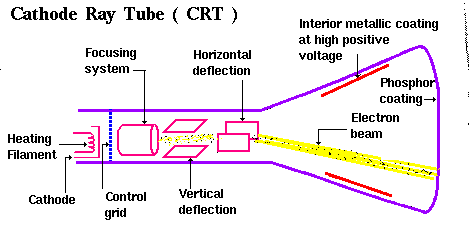
Reference: https://www.semanticscholar.org/paper/Simulation-of-cathode-ray-tube-Maiti-Rajagopal/ca0d214bf66cd8a3f01d175e0455dcc37deb71f4/figure/0

Reference: https://www.javatpoint.com/fullformpages/images/crt.gif
As electric current pass through the filament, it heats up and emits electron. This means electrical energy is converted to heat energy. The difference in electrical energy potential from anode and cathode increases the acceleration of electrons towards the fluorescent screen. This means electrical potential energy is converted kinetic energy of electrons. The high speed electrons then smash the screen and produce flourescence (light).
So that means electrical potential energy = kinetic energy
eV = 1/2 mv^2
electron charge, e = 1.6 x 10 ^ -19 C
electron mass, m = 9.1 x 10 ^ -31 kg
v = final velocity of electron
v^2 = 2eV/m
Example of question:
KE = 1.2eV

Reference: https://images.slideplayer.com/39/10862668/slides/slide_5.jpg